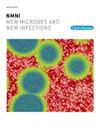Gut microbiota influences Plasmodium falciparum malaria susceptibility
IF 5.4
Q2 INFECTIOUS DISEASES
引用次数: 0
Abstract
Background
The gut microbiota has recently been associated with malaria susceptibility/resistance in animal models and humans. This study aimed to assess its influence on malaria attack and Plasmodium parasitemia in children living in a malaria-endemic area of Mali.
Methods
Healthy children were enrolled in a 16-month cohort study in Bandiagara. Their gut bacteria and fungi community structures were characterized via 16S and ITS metabarcoding at enrolment. Clinicians monitored malaria attacks. Asymptomatic Plasmodium carriage was assessed by real-time polymerase chain reaction.
Results
Of the 300 children, 107 (36 %) had at least one malaria attack, and 82 (27 %) had at least one episode of asymptomatic Plasmodium parasitemia. The gut bacterial community structure, but not the fungal community, was associated with susceptibility/resistance to both malaria attacks and asymptomatic P. falciparum parasitemia. Higher gut bacteria richness was independently associated with susceptibility to both asymptomatic parasitemia episodes and malaria attacks. 17 bacteria, and 7 fungi were associated with susceptibility to malaria attacks, and 8 bacteria, and 3 fungi were associated with resistance. 15 bacteria and 13 fungi were associated with susceptibility to asymptomatic Plasmodium parasitemia episodes, and 19 bacteria and 3 fungi were associated with resistance.
Conclusion
Further studies are needed to confirm these findings, which point the way to strategies aimed at reducing the risk of malaria by modulating gut microbiota components in at-risk populations.
肠道菌群影响恶性疟原虫疟疾易感性
最近,在动物模型和人类中,肠道微生物群与疟疾易感性/耐药性有关。本研究旨在评估其对生活在马里疟疾流行地区的儿童疟疾发作和疟原虫寄生虫病的影响。方法在Bandiagara对健康儿童进行为期16个月的队列研究。在入组时通过16S和ITS元条形码对其肠道细菌和真菌群落结构进行了表征。临床医生监测疟疾发作情况。实时聚合酶链反应检测无症状疟原虫携带情况。结果300例儿童中,107例(36%)至少发生过一次疟疾发作,82例(27%)至少发生过一次无症状疟原虫感染。肠道细菌群落结构与疟疾发作和无症状恶性疟原虫寄生虫病的易感性/耐药性相关,而与真菌群落无关。较高的肠道细菌丰富度与无症状寄生虫病发作和疟疾发作的易感性独立相关。17种细菌和7种真菌与疟疾易感性相关,8种细菌和3种真菌与耐药性相关。15种细菌和13种真菌与无症状疟原虫感染易感相关,19种细菌和3种真菌与耐药相关。结论需要进一步的研究来证实这些发现,这些发现为通过调节高危人群肠道菌群组成来降低疟疾风险的策略指明了方向。
本文章由计算机程序翻译,如有差异,请以英文原文为准。
求助全文
约1分钟内获得全文
求助全文
来源期刊

New Microbes and New Infections
Medicine-Infectious Diseases
CiteScore
10.00
自引率
2.50%
发文量
91
审稿时长
114 days
 求助内容:
求助内容: 应助结果提醒方式:
应助结果提醒方式:


